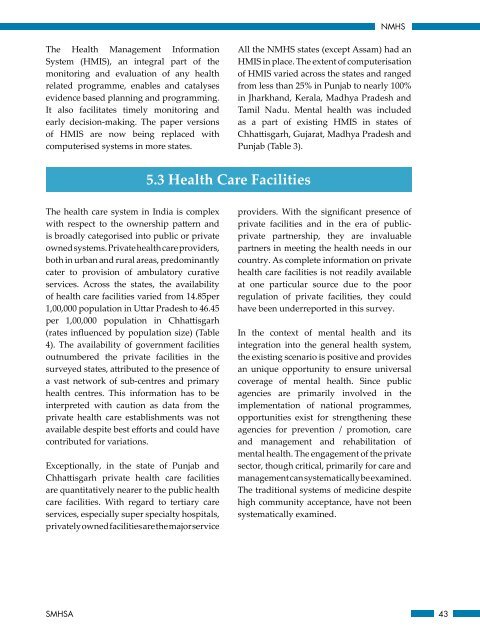National Mental Health Survey of India 2015-16
NMHS%20Report%20%28Mental%20Health%20Systems%29%201
NMHS%20Report%20%28Mental%20Health%20Systems%29%201
You also want an ePaper? Increase the reach of your titles
YUMPU automatically turns print PDFs into web optimized ePapers that Google loves.
NMHS<br />
The <strong>Health</strong> Management Information<br />
System (HMIS), an integral part <strong>of</strong> the<br />
monitoring and evaluation <strong>of</strong> any health<br />
related programme, enables and catalyses<br />
evidence based planning and programming.<br />
It also facilitates timely monitoring and<br />
early decision-making. The paper versions<br />
<strong>of</strong> HMIS are now being replaced with<br />
computerised systems in more states.<br />
All the NMHS states (except Assam) had an<br />
HMIS in place. The extent <strong>of</strong> computerisation<br />
<strong>of</strong> HMIS varied across the states and ranged<br />
from less than 25% in Punjab to nearly 100%<br />
in Jharkhand, Kerala, Madhya Pradesh and<br />
Tamil Nadu. <strong>Mental</strong> health was included<br />
as a part <strong>of</strong> existing HMIS in states <strong>of</strong><br />
Chhattisgarh, Gujarat, Madhya Pradesh and<br />
Punjab (Table 3).<br />
5.3 <strong>Health</strong> Care Facilities<br />
The health care system in <strong>India</strong> is complex<br />
with respect to the ownership pattern and<br />
is broadly categorised into public or private<br />
owned systems. Private health care providers,<br />
both in urban and rural areas, predominantly<br />
cater to provision <strong>of</strong> ambulatory curative<br />
services. Across the states, the availability<br />
<strong>of</strong> health care facilities varied from 14.85per<br />
1,00,000 population in Uttar Pradesh to 46.45<br />
per 1,00,000 population in Chhattisgarh<br />
(rates influenced by population size) (Table<br />
4). The availability <strong>of</strong> government facilities<br />
outnumbered the private facilities in the<br />
surveyed states, attributed to the presence <strong>of</strong><br />
a vast network <strong>of</strong> sub-centres and primary<br />
health centres. This information has to be<br />
interpreted with caution as data from the<br />
private health care establishments was not<br />
available despite best efforts and could have<br />
contributed for variations.<br />
Exceptionally, in the state <strong>of</strong> Punjab and<br />
Chhattisgarh private health care facilities<br />
are quantitatively nearer to the public health<br />
care facilities. With regard to tertiary care<br />
services, especially super specialty hospitals,<br />
privately owned facilities are the major service<br />
providers. With the significant presence <strong>of</strong><br />
private facilities and in the era <strong>of</strong> publicprivate<br />
partnership, they are invaluable<br />
partners in meeting the health needs in our<br />
country. As complete information on private<br />
health care facilities is not readily available<br />
at one particular source due to the poor<br />
regulation <strong>of</strong> private facilities, they could<br />
have been underreported in this survey.<br />
In the context <strong>of</strong> mental health and its<br />
integration into the general health system,<br />
the existing scenario is positive and provides<br />
an unique opportunity to ensure universal<br />
coverage <strong>of</strong> mental health. Since public<br />
agencies are primarily involved in the<br />
implementation <strong>of</strong> national programmes,<br />
opportunities exist for strengthening these<br />
agencies for prevention / promotion, care<br />
and management and rehabilitation <strong>of</strong><br />
mental health. The engagement <strong>of</strong> the private<br />
sector, though critical, primarily for care and<br />
management can systematically be examined.<br />
The traditional systems <strong>of</strong> medicine despite<br />
high community acceptance, have not been<br />
systematically examined.<br />
SMHSA<br />
43


